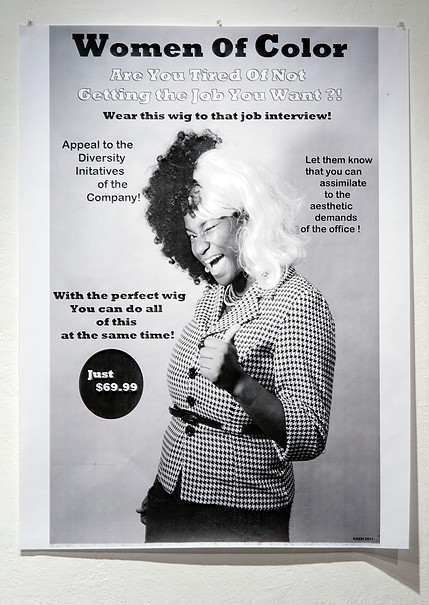Kenyatta A.C. Hinkle is an interdisciplinary visual artist, writer and performer. Her practice fluct
Kenyatta A.C. Hinkle is an interdisciplinary visual artist, writer and performer. Her practice fluctuates between collaborations and participatory projects with alternative gallery spaces within various communities to projects that are intimate and based upon her private experiences in relationship to historical events and contexts. A term that has become a mantra for her practice is the “Historical Present,” as she examines the residue of history and how it affects our contemporary world perspective. Hinkle received her MFA in Art & Critical Studies Creative Writing from CalArts and BFA in Painting from the Maryland Institute College of Art. (text and images from http://www.kachstudio.com)(top image) The Tituba Black Witch of Salem Series is rooted in Maryse Condé’s novel “I, Tituba: Black Witch of Salem”, written in 1992. This piece of historical fiction captures the story of a woman of color who was a pivotal figure during the Salem Witch Trials. Fascinated by Condé’s depiction of Otherness, racism, gender, sexuality, as well as cultural and religious hegemony, Hinkle compiles an abstractly drawn narrative of Tituba’s experiences that intermingles with her own experience of inhabiting a black and pregnant body for the first time.(middle two images) The Lineage of a Kneegrow Series is a body of work that interrogates the historical and contemporary labels that have been assigned to the black body. Riffing off of the homonym Negro/Knee Grow Hinkle creates an elusive identity that blurs fact and fiction allowing the viewer to enter into a a space in which the dichotomies between self-hood vs. collective history and the negotiation between survival and becoming through language take form. Hinkle utilizes performance, educational tools and office supplies to create intertextual dialogues concerning blackness. She also uses sources from: Blaxxploitation film, overheard conversations, racial slurs, rap music, pedigree charts, phrenology charts, religious texts, letters of complaint and overheard conversations.(bottom two images) This series focuses on re-constructing the narratives that took place within late 19th century and early 20th century West African ethnographic photography taken mainly by French colonialist. The photo documentation and, sometimes exploitive constructions were mass produced on postcards and carte-de-vistes and distributed globally. Hinkle uses the metaphor of disease as a meditation on colonialism and postcolonialism interpreted through poetically drawing the act of a virus entering the body in question and rendering the body as a host, in which several mutations occur for the survival of the virus. She links this relationship to the French occupation of Africa and the black female body as a charted territory. Through manipulating the scale of the images and creating interventions through drawing and painting on top of the photos, Hinkle interrogates the power dynamics between the gaze, the subject and the viewer through a term that she has coined: The Historical Present. This term is a means to navigate the residue of history through examining the exotification, and the perception of the black female body when taken out of context through the view of the Other. -- source link
Tumblr Blog : resistingdefinition.tumblr.com
#kenyattaachinkle#colllage#watercolor#performance#blackness#wiitch#otherness




